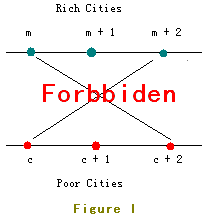JGShining‘s kingdom consists of 2n(n is no more than
500,000) small cities which are located in two parallel lines.
Half of
these cities are rich in resource (we call them rich cities) while the others
are short of resource (we call them poor cities). Each poor city is short of
exactly one kind of resource and also each rich city is rich in exactly one kind
of resource. You may assume no two poor cities are short of one same kind of
resource and no two rich cities are rich in one same kind of resource.
With the development of industry, poor cities wanna import resource from
rich ones. The roads existed are so small that they‘re unable to ensure the
heavy trucks, so new roads should be built. The poor cities strongly BS each
other, so are the rich ones. Poor cities don‘t wanna build a road with other
poor ones, and rich ones also can‘t abide sharing an end of road with other rich
ones. Because of economic benefit, any rich city will be willing to export
resource to any poor one.
Rich citis marked from 1 to n are located in
Line I and poor ones marked from 1 to n are located in Line II.
The
location of Rich City 1 is on the left of all other cities, Rich City 2 is on
the left of all other cities excluding Rich City 1, Rich City 3 is on the right
of Rich City 1 and Rich City 2 but on the left of all other cities ... And so as
the poor ones.
But as you know, two crossed roads may cause a lot of
traffic accident so JGShining has established a law to forbid constructing
crossed roads.
For example, the roads in Figure I are forbidden.

In order to build as many roads
as possible, the young and handsome king of the kingdom - JGShining needs your
help, please help him. ^_^
Each test case will begin with a line containing an
integer n(1 ≤ n ≤ 500,000). Then n lines follow. Each line contains two integers
p and r which represents that Poor City p needs to import resources from Rich
City r. Process to the end of file.
For each test case, output the result in the form of
sample.
You should tell JGShining what‘s the maximal number of road(s) can
be built.
Case 1:
My king, at most 1 road can be built.
Case 2:
My king, at most 2 roads can be built.
Hint
Huge input, scanf is recommended.
假设存在一个序列d[1..9] = 2 1 5 3 6 4 8 9 7,可以看出来它的LIS长度为5。
下面一步一步试着找出它。
我们定义一个序列B,然后令 i = 1 to 9 逐个考察这个序列。
此外,我们用一个变量Len来记录现在最长算到多少了
首先,把d[1]有序地放到B里,令B[1] = 2,就是说当只有1一个数字2的时候,长度为1的LIS的最小末尾是2。这时Len=1
然后,把d[2]有序地放到B里,令B[1] = 1,就是说长度为1的LIS的最小末尾是1,d[1]=2已经没用了,很容易理解吧。这时Len=1
接着,d[3] = 5,d[3]>B[1],所以令B[1+1]=B[2]=d[3]=5,就是说长度为2的LIS的最小末尾是5,很容易理解吧。这时候B[1..2] = 1, 5,Len=2
再来,d[4] = 3,它正好加在1,5之间,放在1的位置显然不合适,因为1小于3,长度为1的LIS最小末尾应该是1,这样很容易推知,长度为2的LIS最小末尾是3,于是可以把5淘汰掉,这时候B[1..2] = 1, 3,Len = 2
继续,d[5] = 6,它在3后面,因为B[2] = 3, 而6在3后面,于是很容易可以推知B[3] = 6, 这时B[1..3] = 1, 3, 6,还是很容易理解吧? Len = 3 了噢。
第6个, d[6] = 4,你看它在3和6之间,于是我们就可以把6替换掉,得到B[3] = 4。B[1..3] = 1, 3, 4, Len继续等于3
第7个, d[7] = 8,它很大,比4大,嗯。于是B[4] = 8。Len变成4了
第8个, d[8] = 9,得到B[5] = 9,嗯。Len继续增大,到5了。
最后一个, d[9] = 7,它在B[3] = 4和B[4] = 8之间,所以我们知道,最新的B[4] =7,B[1..5] = 1, 3, 4, 7, 9,Len = 5。
于是我们知道了LIS的长度为5。
!!!!! 注意。这个1,3,4,7,9不是LIS,它只是存储的对应长度LIS的最小末尾。有了这个末尾,我们就可以一个一个地插入数据。虽然最后一个d[9] = 7更新进去对于这组数据没有什么意义,但是如果后面再出现两个数字 8 和 9,那么就可以把8更新到d[5], 9更新到d[6],得出LIS的长度为6。
然后应该发现一件事情了:在B中插入数据是有序的,而且是进行替换而不需要挪动——也就是说,我们可以使用二分查找,将每一个数字的插入时间优化到O(logN)~~~~~于是算法的时间复杂度就降低到了O(NlogN)~
神人,膜拜~
AC代码:
1 #include<cstdio>
2 #include<algorithm>
3 using namespace std;
4 int num[500011];
5 int ans[500011];
6 int main()
7 {
8 int n,k=1;
9 int len,low,up,mid;
10 int i;
11 int temp1,temp2;
12 while(scanf("%d",&n) != EOF)
13 {
14 for(i=0;i<n;i++){
15 scanf("%d %d",&temp1,&temp2);
16 num[temp1]=temp2;
17 }
18 ans[1]=num[1];
19 len=1;
20 for(i=2;i<=n;i++){
21 low=1;
22 up=len;
23 while(low<=up){
24 mid=(low+up)/2;
25 if(ans[mid]<num[i]) low=mid+1;
26 else up=mid-1;
27 }
28 ans[low]=num[i];
29 if(low>len) len++;
30 }
31 printf("Case %d:\n",k++);
32 if(len==1) printf("My king, at most 1 road can be built.");
33 else printf("My king, at most %d roads can be built.",len);
34 printf("\n\n");
35 }
36 return 0;
37 }
